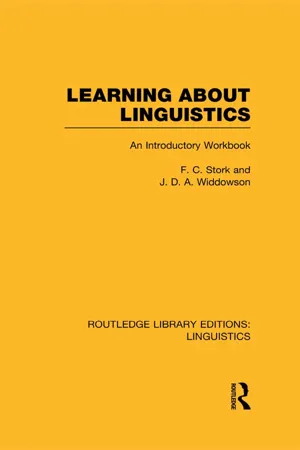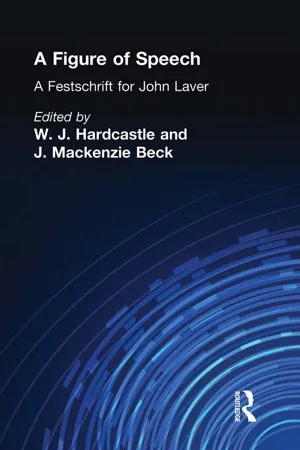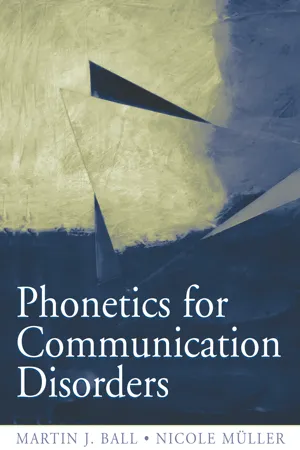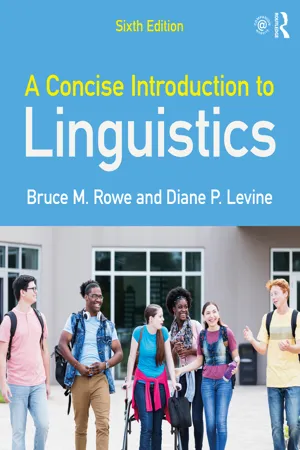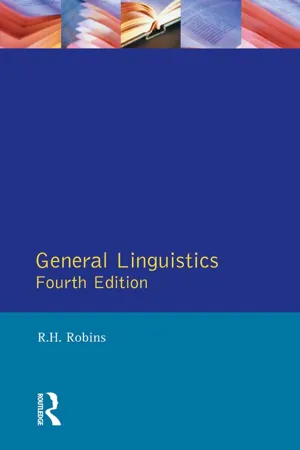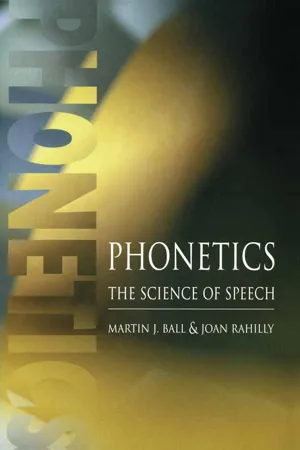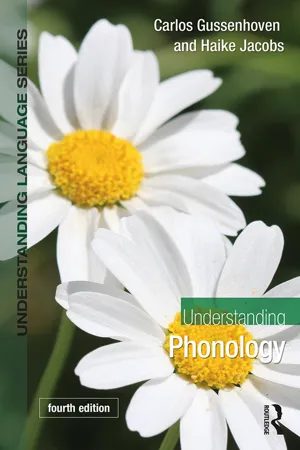Languages & Linguistics
Glottal
Glottal refers to sounds produced by the action of the glottis, the space between the vocal cords in the larynx. In linguistics, glottal sounds are often associated with the glottal stop, a speech sound made by briefly closing the vocal cords. This type of sound is found in various languages and can serve as a consonant or a component of a vowel.
Written by Perlego with AI-assistance
7 Key excerpts on "Glottal"
- eBook - ePub
- F.C. Stork, J.D.A. Widdowson(Authors)
- 2014(Publication Date)
- Routledge(Publisher)
When this takes place in the glottis, it is called a Glottal STOP. In one sense this is not a sound at all but a way of interrupting or starting a sound. The Glottal stop is articulated by allowing pressure to build up behind the closed glottis and by releasing it suddenly. This occurs in some speakers of English when they pronounce the phrase ‘there are’ in such a way as to separate the two words, rather than to link them with the r sound. In some English dialects the Glottal stop is quite common as a replacement for other stop consonants, as for example in the Cockney [ | wɔːɁə] for ‘water’. In some languages the Glottal stop is common as a speech sound in its own right: in German for example, every word that looks as if it begins with a vowel really begins with a Glottal stop. It is in this sense that the Glottal stop is a way of beginning a sound, since a vowel that begins with a sudden release of air after a Glottal stop has a much sharper onset than one which begins with a gradual build-up of the voicing. THE INTERNATIONAL PHONETIC ALPHABET Reproduced by kind permission of the International Phonetic Association, University College, Gower Street, London WCI. Consonants shown according to point and manner of articulation. Symbols on the left of the squares indicate voiceless consonants. Symbols on the right indicate voiced consonants. Fig. 2 Consonants can be produced without blocking the airstream completely, by impeding it in some way so that there is audible friction: the sound [f] is a good example of this. A sound which is produced by audible friction is called a FRICATIVE. One type of fricative is, in fact, produced in the glottis and that is [h]. In English, however, there is usually very little audible friction in [h] and some phoneticians prefer to call it a FRICTIONLESS CONTINUANT - eBook - ePub
A Figure of Speech
A Festschrift for John Laver
- William J. Hardcastle, Janet Mackenzie Beck, William J. Hardcastle, Janet Mackenzie Beck(Authors)
- 2014(Publication Date)
- Routledge(Publisher)
Sweet’s (1877) description. Our research has also shown that in North American English and in Thai, this state of the glottis is one that can precede an initial vowel in modal voice that is not heavily stressed and does not have a Glottal stop before it. We propose that the basic states of the glottis be expanded to include the prephonation state of the glottis used in voiceless unaspirated oral stops and affricates.Fig. 14.3 Prephonation, during the stop in unaspirated [pә].Unphonated
Glottal Stop
Holder (1669 , pp. 60, 72) defined Glottal stop as ‘a stop made by closing the larynx.’ Bell (1867 , pp. 46, 60) defined Glottal stop as a Glottal catch made with the glottis closed and a catch of the breath as in a cough, although he states that the linguistic effect of Glottal stop is softer than in a cough. Sweet (1877 , pp. 6–7) also called Glottal stop a Glottal catch and defined it as a sudden opening or closing of the glottis, citing the same example of a Glottal catch as in an ordinary cough. Noël-Armfield (1931 , p. 107), Heffner (1950 , p. 125), and Jones (1956 , p. 19) defined Glottal stop as a closure and opening of the glottis. Jones added that the glottis must be tightly closed. Ladefoged (1975 , p. 46, 1982 , p. 50) refers to a Glottal stop being made by holding the vocal cords tightly together, also suggesting that Glottal stops occur in coughs. Laver (1994 , pp. 187–188, 206) defines Glottal stop as a maintained complete Glottal closure.Some early visual images of the vocal folds such as the drawings made by A. K. Maxwell from the vocal cords of Stephen Jones of the Phonetics Laboratory, University College London, showed the basic states of the glottis for breath, voice, whisper, and what was called a vigorous Glottal stop. The Glottal stop that occurs in a cough was called an exaggerated form of Glottal stop. The works of both Westermann and Ward (1933 , pp. 52–53) and Ward (1929 , p. 13) contain these drawings made in the 1920s. The drawing of the so-called vigorous Glottal stop closely resembles the laryngoscopic visual images of moderate Glottal stop in our research (cf. Esling , 1999a, p. 360). Discussions of the role of the ventricular folds in the production of Glottal stop can be found in Lindqvist (1969) , whereas an argument against Lindqvist’s views on Glottal stop can be found in Catford (1977 - eBook - ePub
- Martin J. Ball, Nicole Muller(Authors)
- 2014(Publication Date)
- Psychology Press(Publisher)
As we have seen with these five phonation types, there are various states of the glottis, from fully open through partially open to closed and vibrating. It is also possible to close the glottis tightly so that no air is allowed through at all. We can't do this for too long (for one thing the pulmonic pressure will become too great, and we need to open the glottis at some time in order to breathe!). Nevertheless, many languages allow speakers to produce Glottal stops, in other words, to very briefly stop the airflow by snapping the vocal folds together (and causing thereby a brief moment of silence). In some languages, this functions as equivalent to a consonant, while in others, it serves as a word boundary marker when a word begins with a vowel. In English, some speakers use the Glottal stop instead of [t] in words such as “better” (for example many speakers from London, England). Other speakers may use it as a word boundary marker, especially if the second word starts with a vowel, as in “go in.”The five main phonation types have their own phonetic symbols. We can either mark individual sounds, or stretches of speech. Of course, some symbols already stand for voiced or voiceless sounds; therefore voice or voicelessness does not need to be marked by diacritics for these sounds.Voiceless: [p, m̥]; V̥ Whisper: [ɑ̣]; W Voice: [z, s̬]; V Creak: [a̰]; C Falsetto: F (used for stretches of speech; no mark for individual sounds) Glottal stop: [ʔ] (no mark for stretches of speech because, with the glottis stopped, speech is impossible).Combined Phonation Types
Various combined phonation types are possible, although some are encountered more often than others. Voice can be combined with both breath and whisper. Breathy voice requires a glottis more open than for whisper but less than for voicelessness. The airflow is of high volume velocity, and the vocal folds are allowed to flap in this fast flowing airstream (see Fig. 4.7 ). Because the air is flowing at high volume velocity, one cannot speak for very long with this phonation type, as one runs out of breath. Whispery voice , also termed murmur , is somewhat different. Here the vocal folds are relaxed and vibrating, while a small gap at the arytenoid end of the folds allows air to pass through and become turbulent (see Fig. 4.8 - eBook - ePub
- Bruce M. Rowe, Diane P. Levine(Authors)
- 2022(Publication Date)
- Routledge(Publisher)
In both cases, you should be able to sense the vocal folds being pressed together. A consonant is a speech sound that is produced when the airstream is constricted or stopped (and then released) at some place along its path before it escapes from the body. The glottis is at one end of the vocal tract above the larynx. The lips are at the other end. In the initial sound of pat, the lips touch each other in a momentary obstruction of the airstream. This type of obstruction is called a bilabial stop. The obstructions that occur to create different types of consonants can take place at many locations between the glottis and the lips. Later, we will discuss these different places of articulation as well as the various manners of articulation, stops being only one. Vowels Vowels are sounds that are produced with no closure or obstruction of the airstream. The differences between various vowel sounds depend on which cavity (oral, nasal, or pharyngeal) is employed and what shape is formed in that resonance chamber. The shape of the oral cavity is primarily affected by the position of the lips and the placement of the tongue. For instance, the vowel sound in the word to is produced with the high point of the tongue in the back of the mouth, the oral cavity relatively closed, and the lips rounded. The vowel sound in cat is produced with the high point of the tongue toward the front of the mouth, the oral cavity relatively open, and the lips spread. These differences are explained and diagrammed later in the chapter. A vowel is a speech sound produced without constriction or stoppage. Consonants: place of articulation Articulation is the production of speech sounds by the movement of the speech organs. We have noted that once out of the glottis, the airstream may or may not be obstructed in the cavity above the glottis. If it is not obstructed, we have a vowel; if it is obstructed, then we have a consonant - eBook - ePub
- R.H. Robins(Author)
- 2014(Publication Date)
- Routledge(Publisher)
Expiration is ordinarily silent. But air passing under pressure, if checked or obstructed, generates noise. The operation of wind instruments in music, and the sighing of the wind in trees or round rocks or on a hillside are familiar examples of this. In speaking one is checking and obstructing the outward passage of expiratory air at various places in the vocal tract and in various ways. Perceived differences in speech sounds are the results and the correlates of differences in the place and manner of this interference, and the terms and categories of phonetic description are in the main drawn from this source.A brief account of the principal articulatory processes will be given here. For a complete general description recourse should be had to a textbook on phonetics, and for a detailed description of the sounds of a particular language a book on the phonetics of that language should be consulted.43.2The organs of speech3.2.1The glottisAir passing up and out through the windpipe passes through the glottis, a part of the larynx, itself part of the throat. Across the glottis lie two membranes known as the vocal cords, though they are more in the form of curtains. These can be pulled together wholly to cut off the outward (or inward) stream of air, as in ‘holding one's breath’. They can be relaxed and folded back at each side, as in normal breathing, when they permit the air to flow through freely and silently. Momentary obstruction by the vocal cords followed by the release of expiratory air produces a sound called the Glottal stop, used in a number of languages, for example Arabic, and frequently in the Cockney dialects of English (as in Cockney pronunciation of what a lot ). The vocal cords may also be held together tautly so that the air stream vibrates them regularly at different speeds in its forced passage through them. This vibration is known technically as voice or voicing, and is a component of many of the speech sounds of all languages. It is also the source of voice pitch, the material of intonation (and of singing), and of the pitch phenomena of ‘tone languages’ (3.5.4 ). It may be felt externally by lightly touching the front of the larynx or ‘Adam's apple’ with the finger-tip while humming or saying Ah . Its absence is called voicelessness, and several pairs of similarly articulated sounds are distinguished in many languages as voiced and voiceless (eg the initial sounds on van and fan , and the d 's of did as against the t 's of tit - eBook - ePub
Phonetics
The Science of Speech
- Martin J Ball, Joan Rahilly(Authors)
- 2014(Publication Date)
- Routledge(Publisher)
utterance usage. It is, however, inaccurate, and so no more helpful than the first usage just described. Although it is true that certain sounds traditionally termed consonants do seem to need a short vowel after them (such as [p], [b], [t], [d], and [k]), many others do not. Tr y, for example to say a long ‘s’ sound without adding a vowel at the end. It should sound a bit like a hissing snake, and is quite easy to produce without a vowel. Similarly, a long ‘m’ sound will be like a humming noise and does not require a vowel. Some languages even have words that consist simply of a consonant sound: the sound [v] in Russian is a preposition meaning ‘in’ (written in the Cyrillic alphabet as ʙ).The utterance usage also will be avoided in this book therefore. However, it is an advance in that it moves us away from writing and towards sound as a definition of these terms. Our next two definitions are often found in the phonetics and phonology literature, and are best considered together. We will terms these the ‘phonetic’ and the ‘phonological usage’, and they derive from attempts by speech scientists to define the terms strictly. One such definition looks at how speech sounds are produced. Some speech sounds are articulated with a relatively free flow of air through the mouth, in that the airflow remains smooth and does not become turbulent. Others are made with a narrowing in the oral cavity (produced by movement of the tongue towards the roof of the mouth, for example). In these cases, airflow is likely to become turbulent, or be blocked altogether for a while. In phonetic usage, the sounds with a free passage of air are termed ‘vowels’ and those with a blocked or turbulent airflow are called ‘consonants’.The phonological definition looks at how sounds work in syllables rather than how they are made. All syllables require a nucleus (or central portion) that is sonorant (referring to the sound’s inherent loudness, and roughly meaning clearly perceptible), and optionally beginning and end portions that are less sonorous. Individual languages have different constraints as to whether these beginning and end portions (‘onset’ and ‘coda’) are optional and what precise sounds can go into these three positions. The nucleus position is occupied by vowels, and the onset and coda by consonants under this usage system.These two approaches to defining consonants and vowels overlap in the majority of cases. However, there some instances where they do not. Sounds like [w] in ‘went’ and [j]1 in ‘yes’ are clearly consonants under the phonological usage (they can be onsets but not nuclei in syllables); however, they are produced with a relatively free passage of air and no turbulence and so would appear to be vowels under the phonetic usage. This is reflected in some of the names these sounds are given in phonetics texts: semi-vowels (older usage, semi-consonants). The same problem is often claimed to occur with sounds like [l] in ‘light’ and ɹ2 - eBook - ePub
- Carlos Gussenhoven, Haike Jacobs(Authors)
- 2017(Publication Date)
- Routledge(Publisher)
Beamter ‘civil servant’ ([bəʔamtɐ]).To summarize section 2.2 , the larynx produces either no sound (open glottis) or a phonated sound. In the former case, the segment is said to be voiceless , and the acoustic energy created for the speech sound lies at a location above the larynx. In the other case, the phonation is either voice or whisper. Three types of voice were distinguished, normal voice, commonly known as modal voice, breathy voice and creaky voice. Finally, a brief closure before or after voicing represents a Glottal stop. In the next section, we consider the ways in which an acoustic source can be created at a location above the larynx, as well as the ways in which the phonated laryngeal sound source can be modified by differences in the shape of the supralaryngeal cavities, which together form the vocal tract.2.3 The Vocal Tract
Figure 2.4 Cross-section of the vocal tract.The vocal tract extends all the way to the lips (see Figure 2.4 ). It consists of the pharynx and the mouth , to which an extra tube extending to the nostrils may be coupled, the nasal cavity . This (potentially bifurcating) tube acts as a resonator, modifying the sound produced at the glottis. The sound produced by a vibrating glottis can be modified by changing the position of the tongue, jaw and lips so as to produce a range of different vowel qualities. Second, inside the vocal tract there are further opportunities for generating sound, which in their turn will be modified by the shape of the vocal tract in front of the sound source. For instance, the tongue can be brought up against the roof of the mouth to form a constriction that generates friction when air is passed through it, as during [s] and [x]. In this section, we describe the three parts of the vocal tract mentioned above, and in section 2.4 we deal with the positions that the tongue, jaw and lips may assume to produce different vowels. In section 2.5
Index pages curate the most relevant extracts from our library of academic textbooks. They’ve been created using an in-house natural language model (NLM), each adding context and meaning to key research topics.
Explore more topic indexes
Explore more topic indexes
1 of 6
Explore more topic indexes
1 of 4
